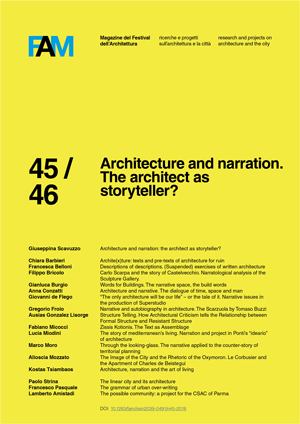Published 2019-01-02
Keywords
- art of living,
- self,
- narration
How to Cite
Abstract
This paper draws from the idea of philosophy as a “life art” - as discussed by philosopher Alexander Nehamas in his book The Art of Living - in order to highlight a hidden connection between architecture, as a creative practice, and the narration of the self.
Can the criteria for a great architecture be reduced to standards and values that are deemed ‘universal’? Or should concepts such as “originality”, “authenticity”, and “uniqueness” be regarded context-dependent and determined retrospectively, only relevant within the narration of a unique personal creative course?
Through a short, imaginary story - which is based on actual historical events - I will argue that the value and impact of every architectural creation cannot always be inherently defined but are usually directly related to what is called “the care of the self”. What I intend my story to tell is that no ‘recipe’ for great architecture exists for someone to follow, precisely because every exemplary architectural creation is always constructed on the scaffolding of an exemplary life. Exemplary not in a moral sense, but in the aesthetic sense of a narration related to the art of living.
Likewise, if every influential architectural work is based on a personal biography then the creative potential of architecture cannot but be intertwined with the question of a narration of the self that is focused on the self-construction of the architect as a person.
At the same time narration is often used as a means to transcend the objective foundations and limits of architectural creation and in order to further establish a social distinction; a distinction (in Bourdieuan terms) between the architects and the Architect. From Le Corbusier and Louis Kahn to Rem Koolhaas and Bjarke Ingels the various efforts to narrate a unique biography are nothing but rhetorical techniques used in the framework of a persuasion strategy. The moral of all these narratives is that the person actually matters more than the project. In other words, architecture’s value, impact and command are related to the creation of the architect as a person as much as - if not more than - architectural creation itself.
References
- ARMSTRONG R. (2009) – “Oedipus as Evidence: The Theatrical Background to Freud's Oedipus Complex”. PSYART: A Hyperlink Journal for the Psychological Study of the Arts (December).
- http://www.psyartjournal.com/article/show/armstrong-oedipus_as_evidence_the_theatrical_backg
- [last accessed 29 July 2015].
- BAKER G. H. (1996) – Le Corbusier, the Creative Search: The Formative Years of Charles-Edouard Jeanneret, Van Nostrand Reinhold - E & F N Spon, New York - London.
- BROOKS A. H. (1997) – Le Corbusier's Formative Years, Charles-Edouard Jeanneret at La Chaux-de-Fonds, The University of Chicago Press, Chicago.
- HUGHES G. J. (2013) – The Routledge Guidebook to Aristotle’s Nicomachean Ethics, Routledge, London.
- LE CORBUSIER (1999) – Le Corbusier Talks with Students, from the Schools of Architecture, Princeton University Press, New York.
- LEITER B. (2007) – Nietzsche and Morality, Oxford University Press, Oxford.
- MARTIN L. H., GUTMAN H., HUTTON P. H. (1988) – Technologies of the Self: A Seminar with Michel Foucault, Amherst, University of Massachusetts Press.
- NEHAMAS A. (1998) – The Art of Living, Socratic Reflections from Plato to Foucault, University of California Press, Los Angeles.
- PICHLER G. (2010) – “Bertold Löffler’s Bookplate for Sigmund Freud”. Psychoanalysis and History, 12/1 (January).
- RICHARDS S. (2003) – Le Corbusier and the Concept of Self, Yale University Press, New Haven, CT.
- SEGAL C. (1993) – Oedipus Tyrannus: Tragic Heroism and the Limits of Knowledge, Twayne Publishers, New York.
- TSIAMBAOS K. (2013) – “Après l’écrasement: d’Eleusis à Delphes”. In L’invention d’un architecte. Le voyage en Orient de Le Corbusier, Fondation Le Corbusier - Éditions de la Villette, Paris.
- VON MOOS S., RÜEGG A. (2002) – Le Corbusier before Le Corbusier, Yale University Press, New Haven, CT.

